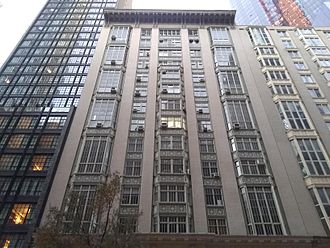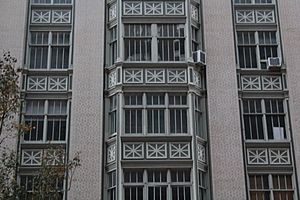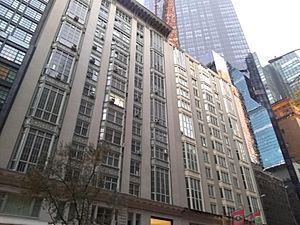130 West 57th Street facts for kids
Quick facts for kids 130 West 57th Street |
|
|---|---|
 |
|
| General information | |
| Type | Commercial |
| Address | 130 West 57th Street |
| Town or city | Manhattan, New York |
| Country | United States |
| Coordinates | 40°45′53″N 73°58′43″W / 40.76467°N 73.97868°W |
| Groundbreaking | 1907 |
| Opened | 1908 |
| Owner | 130 West 57 Company |
| Height | |
| Architectural | 150 ft (46 m) |
| Technical details | |
| Floor count | 15 |
| Design and construction | |
| Architect | Pollard and Steinam |
| Developer | 130 West 57th Street Corporation |
| Main contractor | William J. Taylor Co-Operative |
| Designated | October 19, 1999 |
| Reference no. | 2042 |
130 West 57th Street is an office building in New York City. It is located on 57th Street in Midtown Manhattan. This building was constructed between 1907 and 1908. It was designed by the architects Pollard and Steinam. They also designed the similar building next door at 140 West 57th Street at the same time.
These buildings were special because they were made for artists. They offered spaces where artists could both live and work. The building is 15 stories tall. Its front has 14 stories, plus a small top floor called a penthouse. The bottom two floors are made of light-colored stone, while the upper floors are brick. The building has large windows, some of which are two stories high. These were perfect for artists who needed lots of light.
Even though it was built for artists, many different people lived there. These included lawyers, stockbrokers, and teachers. In 1937, it became a building with apartments for rent. Later, in the late 1900s, it was changed into an office building. In 1999, the city officially recognized 130 West 57th Street as an important landmark.
Contents
Where the Building Is
130 West 57th Street is on the south side of 57th Street. It sits between Sixth Avenue and Seventh Avenue. This spot is just two blocks south of Central Park in Midtown Manhattan, New York City. The land it sits on is about 80 feet wide and 100 feet deep.
The building is right next to 140 West 57th Street on its west side. To its east is the Parker New York hotel. Many other famous buildings are nearby. These include Carnegie Hall, the Metropolitan Tower, and the Russian Tea Room.
This part of West 57th Street became a center for artists. This happened after Carnegie Hall opened in 1891. Many buildings in this area were built for artists and musicians. These include 130 and 140 West 57th Street, the Rodin Studios, and the Osborne Apartments.
Building Design
Pollard and Steinam designed 130 West 57th Street. They also designed the nearby 140 West 57th Street. Both buildings were built at the same time and look very similar. They were made to be studio apartments for artists. 130 West 57th Street is about 150 feet tall. The front part has 14 stories, and the back part has 12 stories. It is one of the few old artist studio buildings left in New York City. These buildings had separate spaces for artists to live and work.
Outside Look
The front of the building faces 57th Street. It has five vertical sections with metal windows. These sections are separated by brick columns. The sections on the far left, in the middle, and on the far right are wider. Two narrower sections are in between them. The back of the building is made of brick.
The bottom two floors make up the base of the building. The main entrance is in the middle. It is made of rough, textured limestone blocks. The entrance has an arch with decorative stones. A double door leads inside, with a small set of steps. A metal and glass cover was added above the entrance in 2000. The rest of the first floor has shops or store entrances. Above the second floor, there is a decorative ledge made of terracotta.
The 12 floors above the base look similar. They have different types of windows. The windows in the wide sections, and some in the middle section, stick out a little. The windows in the narrow sections do not stick out. All the windows have olive-painted panels between them on each floor. There is another decorative ledge above the 14th floor. This ledge has large iron brackets supporting it.
Inside Spaces
The building was designed with 36 studios. Its location on the south side of 57th Street was important. This street is wider than others, so the studios got lots of natural light from the north. This was great for artists. The studios had high ceilings, which were perfect for displaying large artworks.
The large studios facing 57th Street were two stories high. Each of these had a living room, kitchen, four bedrooms, and rooms for servants. Smaller studio rooms were located behind the narrow sections. Some of these could be used as separate apartments. Even smaller apartments were in the back of the building. They had two bedrooms and a small kitchen.
The building had separate elevators for people and for moving things. It also had useful features for residents. These included a vacuum cleaning system, a laundry room, and telephone service in every home.
In 1987, the building was changed. It became an office building with commercial spaces. Today, it has 46 units. Ten of these are still used for homes.
Building History
Cooperative apartments became popular in New York City in the late 1800s. This was because many people were moving to the city, and housing was crowded. Some co-ops were made just for artists, like the Bryant Park Studios. But these were often full and didn't have enough space for artists to live and work.
The 67th Street Studios were built between 1901 and 1903. They were the first artist co-ops in the city designed with two-story living and working areas. These were very successful. This led to more artist studios being built in the area.
Early Artist Studios
In 1907, an artist named Robert Vonnoh bought four old townhouses on West 57th Street. He then transferred ownership to the 130 West 57th Street Corporation. This company decided to build a large apartment house there. They hired Pollard and Steinam to design it. The architects also designed the similar building next door at 140 West 57th Street. Construction for 130 West 57th Street began in September 1907. The building was finished in October 1908.
Even though it was advertised for artists, many different professionals lived at 130 West 57th Street. The famous writer William Dean Howells lived there. His son, architect John Mead Howells, also lived there for a time. The painter Childe Hassam was another resident. He sometimes showed the building's unique windows in his paintings.
The building's outside changed little over the years. Some shops were added on the ground floor. In 1922, the entrance stairs were moved back to make 57th Street wider.
Later Years
In 1937, the building was changed into rental apartments. A company called Met Life bought it in 1938. Later, in 1945, Paul S. Hitlin bought the building. Ownership then passed to Abram Jedwabnik. After Abram passed away, his brother David continued to manage the building.
Through the mid-1900s, many famous people lived or worked at 130 West 57th Street. These included musicians like Ray Charles and The Rolling Stones. The singer Tony Bennett lived on the ninth floor. The film director Woody Allen also had his production company's studios there.
In the 1970s, a restaurant called the Irish Pavilion was on the ground floor. In the 1980s, David Jedwabnik's daughter, Mira Van Doren, and her son Daniel took over managing the building. They updated the hallways and mosaic tiles in the 1990s.
In 1991, Planet Hollywood opened a restaurant next door at 140 West 57th Street. The Motown Cafe and Planet Hollywood's shop also used parts of 130 and 140 West 57th Street. On October 19, 1999, 130 West 57th Street was officially named a city landmark.
By 2000, the building was mostly used for offices. Only seven apartments were left. The Planet Hollywood restaurant moved to Times Square by late 2000. In 2016, a famous tailor from London, H. Huntsman & Sons, opened a store at 130 West 57th Street. This was their first permanent location in New York.
Images for kids
See also
 In Spanish: 130 West 57th Street para niños
In Spanish: 130 West 57th Street para niños




